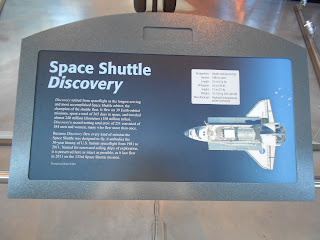This is the actual Shuttle, not a replica, that flew over 39 missions with a total of 365 days in space.
The best part of the museum for me were the docents. These are the folks that explain what you are seeing, bringing the exhibit to life. I was so impressed and thrilled that all of our docents were senior gentlemen, retired military men dressed in navy sport coats who definitely knew what they were talking about. Most of them had flown aircraft themselves back in their day. I found them to be sincere, knowledgeable and happy to share detailed information with the young people. It made me so happy to think that these guys, and I must have seen twelve of them, probably volunteer their time in this Smithsonian Museum filled with airplanes from every war. What struck me the most was how much alike they all seemed and how much they reminded me of my own Dad, an engineer.
We got a good look at a space suit which costs over two million dollars to make. Gold plating is on the face shield to keep the eyes protected from cosmic rays. Fourteen layers make up the suit which comes in three sizes, S-M-L. Only the gloves and boots are personalized for each astronaut.
We learned that the three programs before the Shuttle were the Mercury (a one man capsule), the Gemini (meaning twin, a two man capsule) and the Apollo, which put the first man on the moon. Most of these rockets were disposable. The Shuttle was different in that it could be landed and reused. Some of us can remember when two of the Space Shuttles were lost to explosions, the Challenger in 1986 and the Columbia in 2003. The other four were reused many times, with the Discovery having flown on the most missions.
A classroom lab was part of this field trip at the museum. We learned that solid and liquid rocket fuels were used to launch the Shuttle into space.
John participated in the experiment using a balloon, a straw, a guide wire and 14 paperclips to see how many paperclips the inflated balloon could carry up the string when it was released.
Two hours went by very quickly, and we hadn't even begun to see the many planes on display. We will have to return again as a family to visit those.
John and his buddy napped in the bus on the way home. I enjoyed getting to know some of his classmates and learned many new things about the Space Shuttle program.











